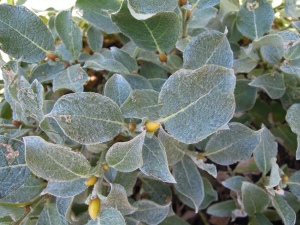Introduction
In May 2018, I was intrigued when I learnt that the Royal Botanic Garden Edinburgh had been running a project for almost twenty years to save endangered native alpine plants. On further investigation, I discovered that one of these plants was the woolly willow (Salix lanata). I instantly knew that I had to create a design that highlighted not only the species itself, but also its vulnerability to climate change. The synergy between the woolly willow and Woolly Originals could not be ignored!

The woolly willow is a native, low growing, alpine shrub found in the remote glens of Scotland. It has beautiful pale green leaves with a "woolly" surface, and distinctive orange-yellow catkins. It is classified as a montane, subarctic willow shrub. As a dioecious plant, the male and female catkins occur on separate plants and it needs many of both to produce seeds.
But, the woolly willow is at risk of extinction due to climate change. Less snow cover leads to greater exposure which means that the plant may be eaten by grazing deer and sheep during the winter.
Research

To get a feel for the plant, I first visited RGBE's Herbarium. Lesley Scott, the Assistant Herbarium Curator, was incredibly helpful and knowledgeable about this plant. With her assistance, I was able to view many of the pressed specimens. I also observed a number of living plants close by the East Gate at the Botanic Garden.

Dr Heather McHaffie, who helped lead the plant's regeneration plan, was also very helpful. She explained to me the details of the project and very kindly showed me the nursery where the willow and a number of other native plants are being propagated and grown from seed for reintroduction into the wild, as part of the Scottish Plant Project. Details of the plant's regeneration action plan are detailed at the foot of this article.

Design
I wanted my design to detail both the willow itself but also to impart the message that climate change and grazing could potentially lead to the plant's extinction.
I first chose representative colours from Jamieson's of Shetland Spindrift collection. I decided on two colours for the background, Conifer or Pine Forest, and Laurel for the leaves. For the catkins, I selected Orkney Wool DK in Mandarin from Be Inspired Fibres in Edinburgh. Thank you, Mei, who owns and runs this lovely yarn shop in Edinburgh, for helping me select a suitable Scottish wool in a suitable colour.
After several attempts, I was finally happy with an interpretation of the woolly willow. I then considered how to detail the effects of climate change which was more challenging. Eventually, I knew what I wanted. The resulting pattern shows a spread of the leaves which begin densely but are abruptly halted in a stark linear manner. This is the "grazing line" where a lack of snow cover in the winter means the plants are being eaten by deer and sheep. This is the front pattern. The back pattern of the bag is simply the background colour of Pine Forest or Conifer, representing what will happen if climate change is allowed to continue and escalate.
Finally, I decided that Woolly bags made in this pattern, would be lined with a complimentary, beautiful ivory and orange leaf print linen from Scottish Linen in Kirkcaldy, Fife. This would represent the diminishing winter snow.

Launch
Woolly Originals bags in the Save the Willow design will be launched at the Edinburgh Yarn Festival at the Corn Exchange, Edinburgh on Thursday 21st March 2019. Thereafter, they will be available at the Woolly Originals EStore. They will be available in Tool/Pencil Case, Small, Medium and Shopper sizes.
Bibliography
Scottish Natural Heritage (2016). The Species Action Framework Handbook
Action Plan
Woolly Willow Species Action Plan
Due to climate change and changes in land use, many species of Scottish alpine plants are threatened with extinction. One of these plants is the woolly willow (Salix lanata), part of the subarctic willow scrub. It has been listed under both the UK Biodiversity Action Plan (UKBAP) and Annex I of the EC Habitats Directive.
In May 1999, the National Trust for Scotland (NTS) implemented a Species Action Plan to halt the plant's decline. The first step was to survey all known locations of the plant. It was found to be growing in only thirteen sites across Scotland, three of which were considered to be functionally extinct. It had become vulnerable to grazing by deer and sheep due to the reduced snow-lie caused by climate change.
An action plan was drafted and implemented over 2007-12, led by NTS. Seeds and cuttings were taken from specific sites and placed in nurseries at The Royal Botanic Garden Edinburgh (RBGE) as the Scottish Plant Project, and at the NTS Killin plant nursery. The resulting 13-14 month old willows were subsequently planted in their area of collection. From 1999, more than 1580 plants were re-introduced by staff and volunteers from NTS, RGBE and Scottish Natural Heritage (SNH), though mainly during the summers of 2009, 2011 and 2012.
Follow-up surveys appear to suggest that in five of the replanted areas, the population has held at a minimum of 50 plants, the number needed to ensure the viability of the willow at any one site.
This work continues as part of the Montane Scrub Action Group.
Images courtesy of Royal Botanic Garden Edinburgh
